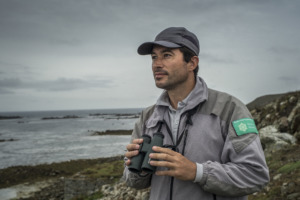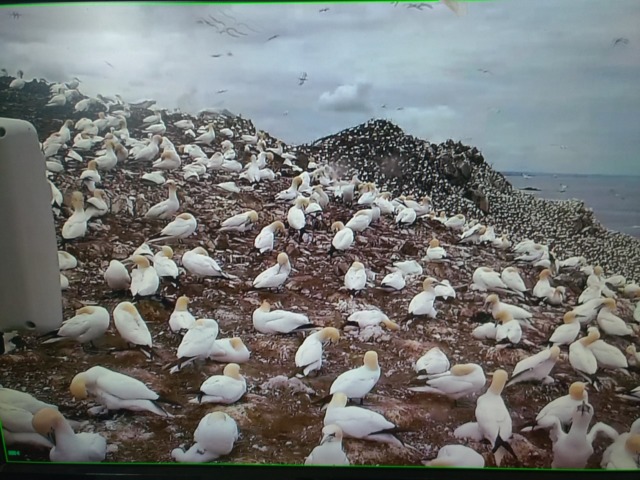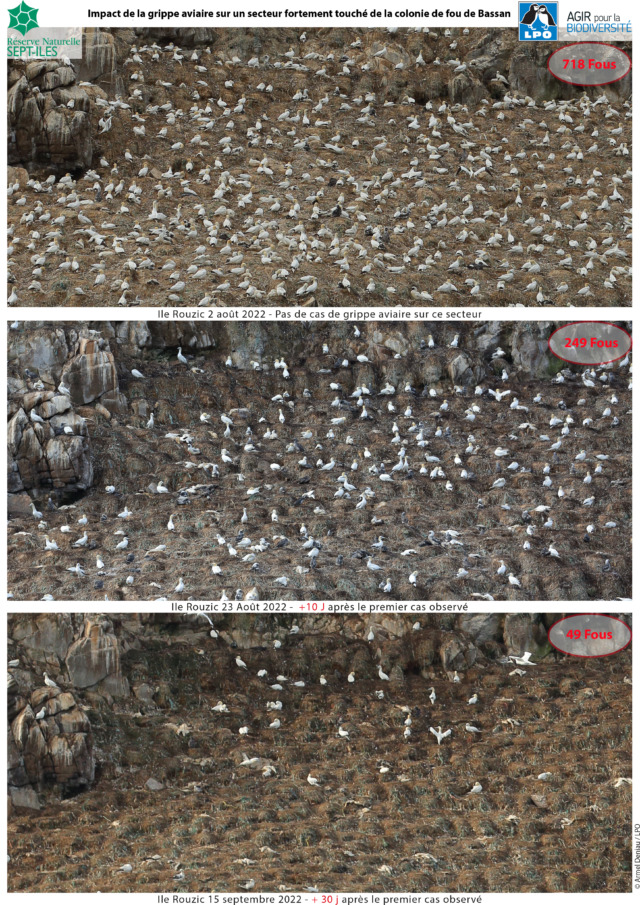
Pascal Provost, conservation officer at the Seven Islands National Nature Reserve (Brittany) for the past 10 years, answers questions from the Tour du Valat concerning the massive mortality of Northern Gannets observed in the reserve the summer of 2022, due to the circulation of a new, highly pathogenic strain of H5N1 avian influenza.
1. Can you give us an overview of the situation you faced this summer due to the circulation of a highly pathogenic avian influenza virus in Northern Gannets?
The Northern Gannet colony in the Seven Islands Reserve is the only nesting site for the species in France and the southernmost colony. 18,967 pairs (AOS) were counted there in 2021, each of which raises a single young bird each year. They are very loyal to their partner and to their breeding site, to which they usually return at the end of January, laying their eggs in April/May and raising their young from June to September.
We have already observed a stagnation in the number of birds in the colony over the last ten years, with the beginning of a decline in 2021. Several long-term scientific studies in close collaboration with the CEFE-CNRS have highlighted several pressure factors on the colony (reduced mackerel resources, reduced adult survival rates, climate change). Thus, we have gone from an average reproductive success of more than 80% in the 1990s to an average success of 40% over the last decade.
While in 2018 the lowest reproductive success ever recorded was 19%, this year’s failure rate of over 90% is well beyond all recent estimates. The first alarm signals for us were the observation of dead adults and then chicks in their nests starting in July. In collaboration with the SAGIR network and the DDPP (Direction Départementale de la Protection des Populations—local administration that protects animal populations), we received confirmation of the presence of a highly pathogenic H5N1 influenza virus in the colony on July 11. According to current analyses, this strain is specific to Northern Gannets and has also been observed in other colonies as far away as North America.

2. How have you been monitoring the situation and what are the initial findings?
Our responsibility in the conservation of such natural heritage is immense. Accustomed to working in a difficult terrain and in dialogue with researchers, and thanks to the financial support of our DREAL (Regional Directorate for Environment, Planning and Housing), we set up several protocols over a period of 4 long months, in the aim of 1) evaluating the effects of the epidemic, particularly on the colony of Northern Gannets, and 2) trying to understand the origins of the only epizootic outbreak since the colony was established on Rouzic Island in 1939.
We decided to maintain the scientific monitoring that had been planned for the breeding season and to add biological sampling sessions. Our long-standing scientific and technical collaborations with research teams such as CEFE (CNRS/University of Montpellier) and LIENS (CNRS, University of La Rochelle), OFB (SD22) and new links with veterinarians and epidemiologists have been invaluable in helping us in this situation. Throughout the breeding season, several missions on the island, at sea and in the air took place to carry out photographic monitoring and sampling (31 individuals analysed, 15 fitted with GPS-GSM tags).
We were able to document the significant decline in colony density as we progressively observed mortalities on the site. At the same time, hundreds of individuals reported dead or dying gannets at sea, on the shore, and also on land, which is quite unusual for such a pelagic species. In parallel with the SAGIR system piloted by the OFB, with the help of local authorities and associations, we are in the process of assessing this dramatic season. It is already clear that thousands of chicks and adults died. These observations echo those reported elsewhere, notably in Scotland on Bass Rock Island.

3. How do you see the future of the colony?
We are facing many questions. How many adults will come back next winter? How will the colony be structured spatially? In one or more groups? Will our monitoring systems remain pertinent, or will they have to be adapted? We are also wondering about the capacity of the virus to persist on the island in the absence of the gannets. Could it remain sufficiently present for individuals returning at the end of January to become infected? Or is there no need to worry about this? Will the returning adults have developed sufficient immunity to avoid being hit as hard by a possible second year of local circulation of a highly pathogenic H5N1 virus? Beyond the emotion that such a massive loss can arouse, we are obstinately pursuing our evaluation work through a rigorous and scientific approach. In memory of our predecessors and the pioneers of the early 20th century who worked to protect the Seven Islands archipelago, we will endeavour to shed light on the origin of this epizootic. It is in this spirit that this 3-minute film was made: https://www.youtube.com/watch?v=zptYpb1Eyos
It is with responsibility and through a scientific and pragmatic approach and on an international scale that we can best analyse and prepare ourselves to respond to this recent pressure which can undermine decades of conservation work. It should raise awareness and remind us of the importance of natural heritage and protected areas in our societies. Millions of tourists have visited the Northern Gannet colony on Rouzic Island, a truly emblematic example of French biodiversity that has contributed to the identity of our Pink Granite Coast territory.